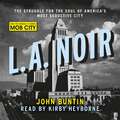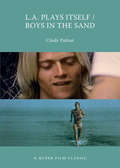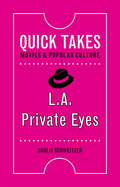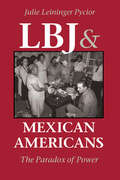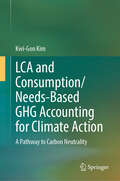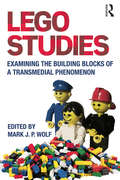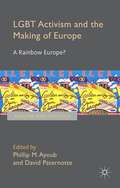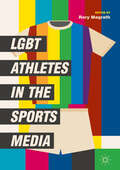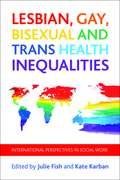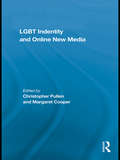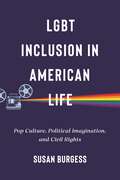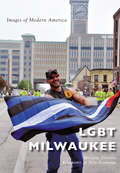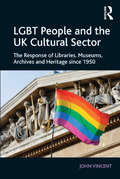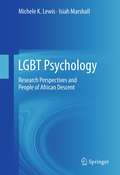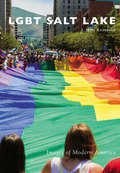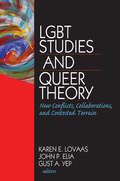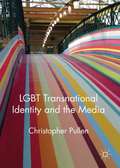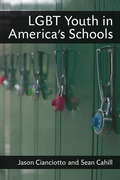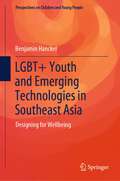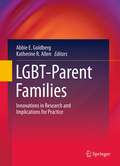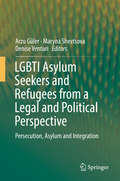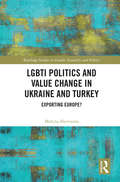- Table View
- List View
L.A. Noir: The Struggle for the Soul of America's Most Seductive City
by John BuntinMid-century Los Angeles. A city sold to the world as 'the white spot of America', a land of sunshine and orange groves, wholesome Midwestern values and Hollywood stars, protected by the world's most famous police force, the Dragnet-era LAPD. Behind this public image lies a hidden world of 'pleasure girls' and crooked cops, ruthless newspaper tycoons, corrupt politicians, and East Coast gangsters on the make. Into this underworld came two men - one L.A.'s most notorious gangster, the other its most famous police chief - each prepared to battle the other for the soul of the city.The Mob had to contend with downtown business (the Chandlers, of LA Times fame), City Hall, and above all the LAPD - and the story is gripping. In these pages you will find the kind of gangsters, cops, pols, and madams familiar from The Big Sleep, Chinatown, and LA Confidential - only this time it's non-fiction, a serious portrait of how the 20th century's most dangerously unaccountable, intrusive model of pre-emptive policing got started. It's a story with great resonance today.Read by Kirby Heyborne(p) 2012 Tantor, Inc
L.A. Plays Itself/Boys in the Sand
by Cindy PattonA Queer Film Classic on two groundbreaking gay arthouse porn films from 1972, both examples of the growing liberalization of social attitudes toward sex and homosexuality in post-Stonewall America. Where Fred Halsted's Boys in the Sand is a frothy romp at a gay beach resort community, Wakefield Poole's L.A. Plays Itself is a dark treatise on violence and urban squalor. Both films represent particular, polarizing moments in the early history of the gay movement.Cindy Patton is a longtime activist and scholar. She is currently professor of sociology at Simon Fraser University in British Columbia.
L.A. Private Eyes (Quick Takes: Movies and Popular Culture)
by Dahlia SchweitzerL.A. Private Eyes examines the tradition of the private eye as it evolves in films, books, and television shows set in Los Angeles from the 1930’s through the present day. It takes a closer look at narratives—both on screen and on the printed page—in which detectives travel the streets of Los Angeles, uncovering corruption, moral ambiguity, and greed with the conviction of urban cowboys, while always ultimately finding truth and redemption. With a review of Los Angeles history, crime stories, and film noir, L.A. Private Eyes explores the metamorphosis of the solitary detective figure and the many facets of the genre itself, from noir to mystery, on the screen. While the conventions of the genre may have remained consistent and recognizable, the points where they evolve illuminate much about our changing gender and power roles. Watch a video of the author speaking about this topic: https://goo.gl/Xr9RFD And also: https://www.dropbox.com/s/mkqw3mplruf7jje/Detective%20Talk%20Full.mp4?dl=0 (https://www.dropbox.com/s/mkqw3mplruf7jje/Detective%20Talk%20Full.mp4?dl=0)
LBJ & Mexican Americans: The Paradox of Power
by Julie Leininger PyciorAs he worked to build his Great Society, Lyndon Johnson often harkened back to his teaching days in the segregated "Mexican" school at Cotulla, Texas. <P><P>Recalling the poverty and prejudice that blighted his students' lives, Johnson declared, "It never occurred to me in my fondest dreams that I might have the chance to help the sons and daughters of those students and to help people like them all over this country. But now I do have that chance--and I'll let you in on a secret--I mean to use it." <P> This book explores the complex and sometimes contradictory relations between LBJ and Mexican Americans. Julie Pycior shows that Johnson's genuine desire to help Mexican Americans--and reap the political dividends--did not prevent him from allying himself with individuals and groups intent on thwarting Mexican Americans' organizing efforts. Not surprisingly, these actions elicited a wide range of response, from grateful loyalty to, in some cases, outright opposition. Mexican Americans' complicated relationship with LBJ influenced both their political development and his career with consequences that reverberated in society at large.
LCA and Consumption/Needs-Based GHG Accounting for Climate Action: A Pathway to Carbon Neutrality
by Kwi-Gon KimThis book reveals causes of the GHG emission accounting practice failure over the last several decades, describes evolution of new tenets of the accounting and remaining tasks, and suggests a new comprehensive integrated accounting in the form of protocol. The latest Intergovernmental Panel on Climate Change (IPCC) assessment report calls for net zero CO2 emissions by 2050 to limit warming to 1.5 degree C. As a result, many countries, cities, and industries are putting forward their greenhouse gas (GHG) emission reduction actions and commitments. But can the countries, cities, and industries meet these ambitious decarbonization goals without a reliable GHG inventory? This book tries to answer this question. It has been argued that there is a need to include LCA and consumption/needs-based GHG emissions as a complimentary indicator to the current approach of production-based GHG accounting emissions. As a shifting of the focus of accounting system after the Paris Agreement, consumption/needs-based approach is newly focused on a more broader accounting approach for NDCs and LDCs with a vision of all of society approach. Traditional national inventory approach to GHG emission accounting has been severely criticized as being too production process-oriented, sector-based approach, less transparent, a lack of public participation, no considerations for human needs and human factors.
LEGO Studies: Examining the Building Blocks of a Transmedial Phenomenon
by Mark J. P. WolfSince the "Automatic Binding Bricks" that LEGO produced in 1949, and the LEGO "System of Play" that began with the release of Town Plan No. 1 (1955), LEGO bricks have gone on to become a global phenomenon, and the favorite building toy of children, as well as many an AFOL (Adult Fan of LEGO). LEGO has also become a medium into which a wide number of media franchises, including Star Wars, Harry Potter, Pirates of the Caribbean, Batman, Superman, Lord of the Rings, and others, have adapted their characters, vehicles, props, and settings. The LEGO Group itself has become a multimedia empire, including LEGO books, movies, television shows, video games, board games, comic books, theme parks, magazines, and even MMORPGs. LEGO Studies: Examining the Building Blocks of a Transmedial Phenomenon is the first collection to examine LEGO as both a medium into which other franchises can be adapted and a transmedial franchise of its own. Although each essay looks at a particular aspect of the LEGO phenomenon, topics such as adaptation, representation, paratexts, franchises, and interactivity intersect throughout these essays, proposing that the study of LEGO as a medium and a media empire is a rich vein barely touched upon in Media Studies.
LGBQ Legislators in Canadian Politics: Out to Represent (Sustainable Development Goals Series)
by Manon TremblayThis book considers the impact that the increasing number of LGBQ politicians in Canada has had on the political representation of LGBTQ people and communities. Based on analysis of parliamentary speeches and interviews with 28 out LGBQ parliamentarians in Canada between 2017 and 2020, Tremblay shows how out LGBQ MLAs and MPs take advantage of their intermediary position between the LGBTQ movement and the state to represent LGBTQ people and communities. For example, the politicians in this study introduce pro-LGBTQ bills, lobby cabinet ministers, act as a bridge between LGBTQ groups and the civil service, and give talks in schools about their identities. Most importantly, they act as role models for LGBTQ people (particularly children and teens) and contribute to lifting the social stigma around sexuality and gender identity. This latest volume in our Sustainable Development Goals series underlines that SDG 16 (Peace, Justice, and Strong Institutions) can only be accomplished with political representation for the LGBTQ community and minority groups in general.
LGBT Activism and Europeanisation in the Post-Yugoslav Space
by Bojan BilićEurope and the European Union are unavoidable, if ambiguous, political references in the post-Yugoslav space. This volume interrogates the forms and implications of the increasingly potent symbolic nexus that has developed between non-heterosexual sexualities, LGBT activism(s) and Europeanisation(s) in all of the Yugoslav successor states. Contributors to this book show how the long EU accession process disseminates discursive tools employed in LGBT activist struggles for human rights and equality. This creates a linkage between "Europeanness" and "gay emancipation" which elevates certain forms of gay activist engagement and perhaps also non-heterosexuality, more generally, to a measure of democracy, progress and modernity. At the same time, it relegates practices of intolerance to the LGBT community to the status of non-European primitivist Other who is inevitably positioned in the patriarchal past that should be left behind. >
LGBT Activism and the Making of Europe
by Phillip M. Ayoub David PaternotteThis book explores the alleged uniqueness of the European experience, and investigates its ties to a long history of LGBT and queer movements in the region. These movements, the book argues, were inspired by specific ideas about Europe, which they sought to realize on the ground through activism.
LGBT Athletes in the Sports Media
by Rory MagrathIn recent years, lesbian, gay, bisexual, and transgender (LGBT) athletes have received more media attention than ever before. Declining levels of homophobia across the Western world has facilitated a greater acceptance of LGBT athletes among heterosexual teammates, fans, and the sports media. Consequently, academic interest in sport, gender and sexuality has also increased substantially. This edited collection combines studies of gender and sexuality with that of the sports media to provide the first-ever comprehensive academic overview of LGBT athletes in the sports media. It draws upon work from a wide range of international scholars to provide an interdisciplinary analysis of improved media coverage of LGBT athletes, as well as the numerous issues and barriers which continue to exist. LGBT Athletes in the Sports Media will be of interest to students and scholars across a range of disciplines, including sociology, media studies, and gender studies.
LGBT Health Inequalities: International Perspectives in Social Work
by Julie Fish and Kate KarbanThis ground-breaking book examines inequalities experienced by LGBT people and considers the role of social work in addressing them. The book is organised in three parts: the first provides a policy context in four countries, the second examines social work practice in tackling health inequalities, and part three considers research and pedagogic developments. The book’s distinctive approach includes international contributions, practice vignettes and key theoretical perspectives in health inequalities, including social determinants of health, minority stress, ecological approaches and human rights. Lesbian, gay, bisexual and trans health inequalities is relevant to social work educators, practitioners and students, alongside an interdisciplinary audience interested in LGBT health inequalities.
LGBT Identity and Online New Media
by Christopher PullenLGBT Identity and Online New Media examines constructions of LGBT identity within new media. The contributors consider the effects, issues, influences, benefits and disadvantages of these new media phenomena with respect to the construction of LGBT identities. A wide range of mainstream and independent new media are analyzed, including MySpace, Facebook, YouTube, gay men’s health websites, message boards, and Craigslist ads, among others. This is a pioneering interdisciplinary collection that is essential reading for anyone interested in the intersections of gender, sexuality, and technology.
LGBT Inclusion in American Life: Pop Culture, Political Imagination, and Civil Rights (LGBTQ Politics #4)
by Susan BurgessA compelling explanation of the American public’s acceptance of LGBT freedoms through the lens of pop cultureHow did gay people go from being characterized as dangerous perverts to military heroes and respectable parents? How did the interests of the LGBT movement and the state converge to transform mainstream political and legal norms in these areas?Using civil rights narratives, pop culture, and critical theory, LGBT Inclusion in American Life tells the story of how exclusion was transformed into inclusion in US politics and society, as pop culture changed mainstream Americans thinking about “non-gay” issues, namely privacy, sex and gender norms, and family. Susan Burgess explores films such as Casablanca, various James Bond movies, and Julie and Julia, and television shows such as thirtysomething and The Americans, as well as the Broadway sensation Hamilton, as sources of growing popular support for LGBT rights. By drawing on popular culture as a rich source of public understanding, Burgess explains how the greater public came to accept and even support the three central pillars of LGBT freedoms in the post–World War II era: to have consensual adult sex without fear of criminal penalty, to serve openly in the military, and to marry legally. LGBT Inclusion in American Life argues that pop culture can help us to imagine unknown futures that lead beyond what we currently desire from contemporary politics, and in return asks now that the mainstream public has come to accept LGBT freedoms, where might the popular imagination be headed in the future?
LGBT Milwaukee (Images of Modern America)
by Don Schwamb Michail TakachOver the past 75 years, gays and lesbians have experienced tremendous social change in America. Gay and lesbian culture, once considered a twilight world that could not be spoken of in daylight, has become today's rainbow families, marriage equality victories, and record-breaking pride celebrations. For a medium-size Rust Belt city with German Protestant roots, Milwaukee was an unlikely place for gay and lesbian culture to bloom before the Stonewall Riots. However, Milwaukee eventually had as many--if not more--known LGBT+ gathering places as Minneapolis or Chicago, ranging from the back rooms of the 1960s to the video bars of the 1980s to the guerrilla gay bars of today.
LGBT People and the UK Cultural Sector: The Response of Libraries, Museums, Archives and Heritage since 1950
by John VincentThis book examines the complex and conflicting relationships between LGBT people and our cultural and heritage organisations including libraries, museums and archives. In this unique book established author John Vincent draws together current good practice, and also highlights issues which urgently still need to be addressed. To set the work of libraries, museums and archives in context, Vincent traces the development of LGBT rights in the UK. He goes on to examine some of the reasons for hostility and hatred against this minority group and critically explores provision that has been made by cultural and heritage organisations. He offers examples of good practice - not only from the UK, but from across the world - and draws up an essential 'charter' for future development. This compelling, practical book should be read by managers and staff in libraries, museums and archives around the world looking for guidance on this important issue.
LGBT Psychology
by Michele K. Lewis Isiah MarshallSame-sex attracted, and non-gender conforming African-Americans are substantial in number, yet underrepresented in the social and behavioral science literature. This volume addresses the issues of African-American LGBT psychology as a case of indigenous psychology. The authors present the research of scholars who are developing theory, practice, and services that are couched within the specific cultural complexities of this population. Some key topics addressed in AFrican-American Issues in LGBT Psychology are gender, spirituality, family, racism, "coming out", generational differences, health and safety issues, urban vs. rural realities, and implications for researchers.
LGBT Salt Lake (Images of Modern America)
by J. Seth AndersonSalt Lake City, located along Utah’s majestic Wasatch Mountains, has historically been a cradle of peculiar people. Before Western culture developed terms for lesbian, gay, bisexual, or transgender (LGBT) identities, diverse communities who recognized their differences from mainstream America made Salt Lake their home. By the early 1970s, a discernible “gay community” had emerged in Salt Lake City, laying the groundwork for future activism and institutions. In the 1970s, publications like Gayzette, the Salt Lick, and the Open Door documented the nascent movement. In the 1980s, amidst devastation from the HIV/AIDS epidemic, marginalized communities valiantly worked to fight the disease and support each other. By the 1990s, LGBT Utahns had gained traction legally and politically with the formation of the first gay straight alliance at East High School and the election of the first openly gay person to the Utah legislature in 1998. The transgender community became more visible in the new century, and by 2008, Utah began to play a prominent role in the battle over marriage equality.
LGBT Studies and Queer Theory: New Conflicts, Collaborations, and Contested Terrain
by Karen LovaasFind out how the tension between LGBT studies and queer theory exists in the classroom, politics, communities, and relationshipsLGBT Studies and Queer Theory: New Conflicts, Collaborations, and Contested Terrain examines the similarities and differences between LGBT studies and queer theory and the uneasy relationship between the two in the academic world. This unique book meets the challenge that queer theory presents to the study and politics of gay and lesbian studies with a collection of essays from leading academics who represent a variety of disciplines. These original pieces place queer theory in social and historical contexts, exploring the implications for social psychology, religious studies, communications, sociology, philosophy, film studies, and women's studies. The book's contributors address queer theory's connections to a wide range of issues, including the development of capitalism, the evolution of the gay and lesbian movement, and the study of bisexuality and gender. Many scholars working in gay and lesbian studies still question the intellectual and political value of queer theory. As a result, queer theory has often been concentrated in the humanities, while gay and lesbian studies are concentrated in the social sciences and history. But this has begun to change in the past 10-15 years, as documented by the 12 essays presented in LGBT Studies and Queer Theory: New Conflicts, Collaborations, and Contested Terrain.LGBT Studies and Queer Theory: New Conflicts, Collaborations, and Contested Terrain includes: historical notes on LGBT studies and queer theory some continuing tensions between LGBT studies and queer theory doubts about whether queer theory can lead to social change an analysis of the current state of "proto-fields" of LGBT studies and queer studies in religion concerns that queer theory&’s "erasure of identity" feeds into late capitalism an analysis of variability in social psychologists&’ studies of anti-homosexual prejudice an exploration of the commodification of queer identities in independent cinema how and why the category of bisexuality has been marginalized a historical review and assessment of recent bisexual theory a case study of Provincetown, Massachusetts an investigation of the interarticulation of race/ethnicity and gender a case study of the struggle to introduce LGBT studies in the curriculum at West Chester University and much moreLGBT Studies and Queer Theory: New Conflicts, Collaborations, and Contested Terrain is an essential read for researchers, academics, and practitioners involved in exploring multifaceted aspects of LGBT Studies and Queer Theory and their points of convergence and divergence.
LGBT Transnational Identity and the Media
by Christopher PullenOffering a critical introduction into LGBT (lesbian, gay, bisexual and transgender) transnational identity in the media, this book examines performances and representations within documentary and fiction oriented texts. An interdisciplinary approach is put forward, revealing new potentials for non western queer identity.
LGBT Youth in America's Schools
by Sean Cahill Jason CianciottoJason Cianciotto and Sean Cahill, experts on lesbian, gay, bisexual, and transgender public policy advocacy, combine an accessible review of social science research with analyses of school practices and local, state, and federal laws that affect LGBT students. In addition, portraits of LGBT youth and their experiences with discrimination at school bring human faces to the issues the authors discuss. This is an essential guide for teachers, school administrators, guidance counselors, and social workers interacting with students on a daily basis; school board members and officials determining school policy; nonprofit advocates and providers of social services to youth; and academic scholars, graduate students, and researchers training the next generation of school administrators and informing future policy and practice.
LGBT+ Youth and Emerging Technologies in Southeast Asia: Designing for Wellbeing (Perspectives on Children and Young People #14)
by Benjamin HanckelThis book investigates the ways in which emerging digital technologies are shaping and changing the worlds of sexuality and gender diverse youth in Southeast Asia. Primarily focused on the Philippines, Indonesia, Singapore, Thailand, and Malaysia, the book examines the potential of digital technologies to enhance wellbeing in and across these contexts. Drawing on multi-site ethnographic field research, interviews, survey data, and online content analysis, the book examines the design and use of websites and content by and for LGBT+ youth. The book innovatively interrogates the design of transnational digital wellbeing initiatives, alongside the digital practices of those the technologies are designed for. It illustrates not only the (im)possibilities of technological design, but also the capacity for design to participate in what Hanckel calls ‘(trans)national digital wellbeing’ processes. He asks us to consider the ways that global technologies are contextual—a paradox that is explored throughout the book. The analysis extends important discussions in youth research, contributing to a greater understanding of how LGBT+ youth are engaging new technologies to participate in identity-making, health and wellbeing, as well as political action. It also considers implications for digital wellbeing and digital health promotion efforts globally with young people who experience marginalisation. In doing so the book makes a critical contribution to understanding the ways that transnational digital interventions get deployed and (at times) incorporated into youth practices.
LGBT-Parent Families: Innovations in Research and Implications for Practice
by Abbie E. Goldberg Katherine R. AllenLGBT-Parent Families is the first handbook to provide a comprehensive examination of this underserved area. Reflecting the nature of this issue, the volume is notably interdisciplinary, with contributions from scholars in psychology, sociology, human development, family studies, gender studies, sexuality studies, legal studies, social work, and anthropology. Additionally, scholarship from regions beyond the U.S. including England, Australia, Canada, and South Africa is presented. In addition to gender and sexuality, all contributors address issues of social class, race, and ethnicity in their chapters.
LGBT-Q Teachers, Civil Partnership and Same-Sex Marriage: The Ambivalences of Legitimacy (Routledge Critical Studies in Gender and Sexuality in Education)
by Aoife NearyThe introduction of legislative structures for same-sex relationships provides a new lens for grappling with the politics of sexuality in schools and society. The emergence of civil partnership and same-sex marriage in Ireland brings to the fore international debates around public intimacy, religion in the public sphere, secularism and the politics of sexuality equality. Building on queer, feminist and affect theory in innovative ways, this book offers insight into the everyday negotiations of LGBT-Q teachers as they operate between and across the intersecting fields of education, religion and LGBT-Q politics. Neary illustrates the complexity of negotiating personal and professional identities for LGBT-Q teachers.
LGBTI Asylum Seekers and Refugees from a Legal and Political Perspective: Persecution, Asylum and Integration
by Arzu Güler Maryna Shevtsova Denise VenturiThis book addresses the ‘three moments’ in lesbian, gay, bisexual, transgender and intersex (LGBTI) asylum seekers’ and refugees’ efforts to secure protection: The reasons for their flight, the Refugee Status Determination process, and their integration into the host community once they are recognized refugee status.The first part discusses one of the most under-researched areas within the literature devoted to asylum claims based on sexual orientation and gender identity, namely the reasons behind LGBTI persons’ flight. It investigates the motives that drive LGBTI persons to leave their countries of origin and seek sanctuary elsewhere, the actors of persecution, and the status quo of LGBTI rights. Accordingly, an intersectional approach is employed so as to offer a comprehensive picture of how a host of factors beyond sexual orientation/gender identity impact this crucial first stage of LGBTI asylum seekers’ journey.In turn, the second part explores the challenges that LGBTI asylum seekers face during the RSD process in countries of asylum. It first examines these countries’ interpretations and applications of the process in relation to the relevant UNHCR guidelines and questions the challenges including the dominance of Western conceptions and narratives of sexual identity in the asylum procedure, heterogeneous treatment concerning the definition of a particular social group, and the difficulties related to assessing one’s sexual orientation within the asylum procedure. It subsequently addresses the reasons for and potential solutions to these challenges.The last part of the book focuses on the integration of LGBTI refugees into the countries of asylum. It first seeks to identify and describe the protection gaps that LGBTI refugees are currently experiencing, before turning to the reasons and potential remedies for them.
LGBTI Politics and Value Change in Ukraine and Turkey: Exporting Europe? (Routledge Studies in Gender, Sexuality and Politics)
by Maryna ShevtsovaLGBTI Politics and Value Change in Ukraine and Turkey focuses on the impact of European Union promotion of LGBTI rights in Turkey and Ukraine, offering a re-evaluation of the mechanisms used by the EU and the domestic and external conditions that result in different outcomes. With the protection of LGBTI rights becoming one of the core principles of the EU, the last two decades have seen a consistently growing commitment of the Union to defending the human rights of LGBTI people, not only in its member states but also internationally. Drawing on rich empirical data, this work uses the cases of Turkey, a candidate state, and Ukraine, a state in the European Neighbourhood, to evaluate the ability of the EU to promote tolerance and diversity in countries where the population has not experienced a radical shift of attitudes toward LGBTI people. Examining the export of 'European values', politics of LGBTI rights in the enlarged European Union, the development of LGBTI rights in Turkey and the transformation of its political system, competing normative powers and LGBTI rights in Ukraine, Maryna Shevtsova traces the ‘Europeanization’ of rights beyond Europe. This book will be of interest to researchers in LGBTI Studies, Eastern European Politics, the European Union and Gender Studies.
